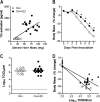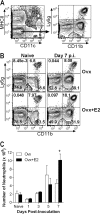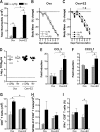17β-estradiol protects females against influenza by recruiting neutrophils and increasing virus-specific CD8 T cell responses in the lungs
- PMID: 24522912
- PMCID: PMC3993800
- DOI: 10.1128/JVI.02081-13
17β-estradiol protects females against influenza by recruiting neutrophils and increasing virus-specific CD8 T cell responses in the lungs
Abstract
17β-Estradiol (E2) treatment limits the pathology associated with pulmonary diseases caused by pathogens, allergens, and asthma, partly by reducing the production of proinflammatory cytokines and chemokines. To test the hypothesis that E2 protects against influenza A virus (IAV) infection by altering the recruitment and activity of innate immune cells and T cells, chemokine concentrations were measured and innate and adaptive immune cells were enumerated from the lungs of E2- and placebo-treated ovariectomized female C57BL/6 mice following infection. Females treated with E2 experienced less morbidity but had similar lung virus titers to placebo-treated females. Females treated with E2 had lower induction of CCL2 but higher CCL3 and CXCL1 responses in their lungs than placebo-treated females. Pulmonary recruitment of neutrophils, NK cells, macrophages, and dendritic cells was increased following infection, but only neutrophil numbers were greater in E2-treated than placebo-treated females. Neutrophils enhance the responses of influenza virus-specific CD8 T cells to promote virus clearance and improve the outcome of infection. Total numbers of virus-specific CD8 T cells were not altered by treatment with E2, but the proportion of gamma interferon (IFN-γ)- and tumor necrosis factor alpha (TNF-α)-producing, virus-specific CD8 T cells was increased. Neutrophil depletion in E2-treated females increased morbidity, reduced pulmonary production of chemoattractants for neutrophils, and reduced IFN-γ production by virus-specific CD8 T cells. Neutrophils mediate both inflammation and tissue repair during IAV infection and are regulated by E2 to improve the outcome of influenza in females.
Importance: Severe influenza is associated with excessive inflammation that leads to tissue damage. We demonstrate that estradiol (E2) is a potent anti-inflammatory hormone that reduces the severity of influenza A virus infection in females. Treatment of female C57BL/6 mice with E2 does not affect virus replication but rather alters the production of chemokines, pulmonary recruitment of neutrophils, and the cytokine responses of virus-specific CD8 T cells to protect females against severe influenza.
Figures






Similar articles
-
Progesterone-Based Contraceptives Reduce Adaptive Immune Responses and Protection against Sequential Influenza A Virus Infections.J Virol. 2017 Mar 29;91(8):e02160-16. doi: 10.1128/JVI.02160-16. Print 2017 Apr 15. J Virol. 2017. PMID: 28179523 Free PMC article.
-
The Flavonoid Isoliquiritigenin Reduces Lung Inflammation and Mouse Morbidity during Influenza Virus Infection.Antimicrob Agents Chemother. 2015 Oct;59(10):6317-27. doi: 10.1128/AAC.01098-15. Epub 2015 Jul 27. Antimicrob Agents Chemother. 2015. PMID: 26248373 Free PMC article.
-
Type I interferon plays opposing roles in cytotoxicity and interferon-γ production by natural killer and CD8 T cells after influenza A virus infection in mice.J Innate Immun. 2014;6(4):456-66. doi: 10.1159/000356824. Epub 2014 Jan 10. J Innate Immun. 2014. PMID: 24435166 Free PMC article.
-
Could Interleukin-33 (IL-33) Govern the Outcome of an Equine Influenza Virus Infection? Learning from Other Species.Viruses. 2021 Dec 15;13(12):2519. doi: 10.3390/v13122519. Viruses. 2021. PMID: 34960788 Free PMC article. Review.
-
Primary and long-term B-cell responses in the upper airway and lung after influenza A virus infection.Immunol Res. 2014 Aug;59(1-3):73-80. doi: 10.1007/s12026-014-8541-0. Immunol Res. 2014. PMID: 24838149 Review.
Cited by
-
Sex-related differences in the efficacy of immune checkpoint inhibitors in malignancy: a systematic review and meta-analysis.Aging (Albany NY). 2021 Jun 4;13(11):15413-15432. doi: 10.18632/aging.203100. Epub 2021 Jun 4. Aging (Albany NY). 2021. PMID: 34086601 Free PMC article.
-
Sex-derived attributes contributing to SARS-CoV-2 mortality.Am J Physiol Endocrinol Metab. 2020 Sep 1;319(3):E562-E567. doi: 10.1152/ajpendo.00295.2020. Epub 2020 Jul 29. Am J Physiol Endocrinol Metab. 2020. PMID: 32726128 Free PMC article. Review.
-
Estradiol, Progesterone, Immunomodulation, and COVID-19 Outcomes.Endocrinology. 2020 Sep 1;161(9):bqaa127. doi: 10.1210/endocr/bqaa127. Endocrinology. 2020. PMID: 32730568 Free PMC article. Review.
-
Covid-19 and its implications for the provision of gynecological services globally.Eur J Obstet Gynecol Reprod Biol. 2022 May;272:58-63. doi: 10.1016/j.ejogrb.2022.02.176. Epub 2022 Feb 26. Eur J Obstet Gynecol Reprod Biol. 2022. PMID: 35286919 Free PMC article.
-
Influenza Pathogenesis: The Effect of Host Factors on Severity of Disease.J Immunol. 2019 Jan 15;202(2):341-350. doi: 10.4049/jimmunol.1801010. J Immunol. 2019. PMID: 30617115 Free PMC article. Review.
References
Publication types
MeSH terms
Substances
Grants and funding
LinkOut - more resources
Full Text Sources
Other Literature Sources
Molecular Biology Databases
Research Materials

